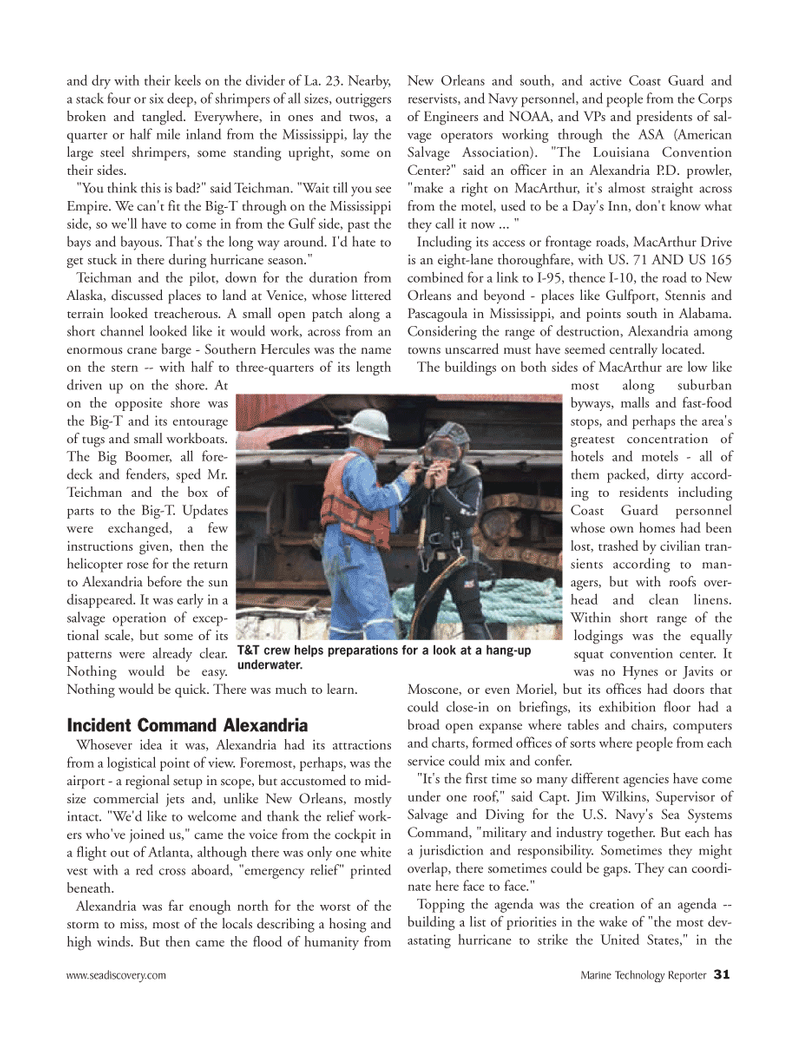
Page 31: of Marine Technology Magazine (November 2005)
Seafloor Engineering
Read this page in Pdf, Flash or Html5 edition of November 2005 Marine Technology Magazine
www.seadiscovery.com Marine Technology Reporter 31 and dry with their keels on the divider of La. 23. Nearby, a stack four or six deep, of shrimpers of all sizes, outriggers broken and tangled. Everywhere, in ones and twos, a quarter or half mile inland from the Mississippi, lay the large steel shrimpers, some standing upright, some on their sides. "You think this is bad?" said Teichman. "Wait till you see
Empire. We can't fit the Big-T through on the Mississippi side, so we'll have to come in from the Gulf side, past the bays and bayous. That's the long way around. I'd hate to get stuck in there during hurricane season."
Teichman and the pilot, down for the duration from
Alaska, discussed places to land at Venice, whose littered terrain looked treacherous. A small open patch along a short channel looked like it would work, across from an enormous crane barge - Southern Hercules was the name on the stern -- with half to three-quarters of its length driven up on the shore. At on the opposite shore was the Big-T and its entourage of tugs and small workboats.
The Big Boomer, all fore- deck and fenders, sped Mr.
Teichman and the box of parts to the Big-T. Updates were exchanged, a few instructions given, then the helicopter rose for the return to Alexandria before the sun disappeared. It was early in a salvage operation of excep- tional scale, but some of its patterns were already clear.
Nothing would be easy.
Nothing would be quick. There was much to learn.
Incident Command Alexandria
Whosever idea it was, Alexandria had its attractions from a logistical point of view. Foremost, perhaps, was the airport - a regional setup in scope, but accustomed to mid- size commercial jets and, unlike New Orleans, mostly intact. "We'd like to welcome and thank the relief work- ers who've joined us," came the voice from the cockpit in a flight out of Atlanta, although there was only one white vest with a red cross aboard, "emergency relief" printed beneath.
Alexandria was far enough north for the worst of the storm to miss, most of the locals describing a hosing and high winds. But then came the flood of humanity from
New Orleans and south, and active Coast Guard and reservists, and Navy personnel, and people from the Corps of Engineers and NOAA, and VPs and presidents of sal- vage operators working through the ASA (American
Salvage Association). "The Louisiana Convention
Center?" said an officer in an Alexandria P.D. prowler, "make a right on MacArthur, it's almost straight across from the motel, used to be a Day's Inn, don't know what they call it now ... "
Including its access or frontage roads, MacArthur Drive is an eight-lane thoroughfare, with US. 71 AND US 165 combined for a link to I-95, thence I-10, the road to New
Orleans and beyond - places like Gulfport, Stennis and
Pascagoula in Mississippi, and points south in Alabama.
Considering the range of destruction, Alexandria among towns unscarred must have seemed centrally located.
The buildings on both sides of MacArthur are low like most along suburban byways, malls and fast-food stops, and perhaps the area's greatest concentration of hotels and motels - all of them packed, dirty accord- ing to residents including
Coast Guard personnel whose own homes had been lost, trashed by civilian tran- sients according to man- agers, but with roofs over- head and clean linens.
Within short range of the lodgings was the equally squat convention center. It was no Hynes or Javits or
Moscone, or even Moriel, but its offices had doors that could close-in on briefings, its exhibition floor had a broad open expanse where tables and chairs, computers and charts, formed offices of sorts where people from each service could mix and confer. "It's the first time so many different agencies have come under one roof," said Capt. Jim Wilkins, Supervisor of
Salvage and Diving for the U.S. Navy's Sea Systems
Command, "military and industry together. But each has a jurisdiction and responsibility. Sometimes they might overlap, there sometimes could be gaps. They can coordi- nate here face to face."
Topping the agenda was the creation of an agenda -- building a list of priorities in the wake of "the most dev- astating hurricane to strike the United States," in the
T&T crew helps preparations for a look at a hang-up underwater.
MTR#3 (17-32).qxd 11/15/2005 2:44 PM Page 31

 30
30

 32
32
